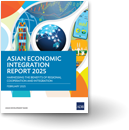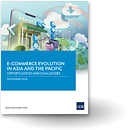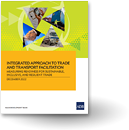Learning from Yolanda: Why the economic impact of disasters in the Philippines is underestimated
Two weeks after Typhoon Yolanda slammed into The Philippines, relief efforts have finally begun to reach the 10 million affected people. In the region that was hardest hit, much of the productive infrastructure has been wiped out. On a positive note, impacts to the wider macroeconomy are expected to be limited. But this masks the longer term influence of frequent natural disasters on economic outcomes in the Philippines.
Destruction increases with development level
The economic impact of natural disasters increases with development level in high hazard countries. This is the result of urbanization and the spatial concentration of capital goods which increases the destructive value of any given shock. This is particularly true at lower levels of development where significant resources are not yet being devoted to risk mitigation.
The Philippines has made important development gains in recent years. It is a middle income country and integrated into regional value chains. Yet, it is the third most exposed country to natural disasters (table 1). 2012 saw 357 natural disasters globally; of those, 21 were located in the Philippines. The frequency of shocks keeps existing social safety nets under continuous stress.
Table 1: World Risk Index (top 10 countries)
|
Exposure Rank |
Country |
Risk Rank |
|
1 |
Vanuatu |
1 |
|
2 |
Tonga |
2 |
|
3 |
Philippines |
3 |
|
8 |
Guatemala |
4 |
|
10 |
Bangladesh |
5 |
|
13 |
Solomon Islands |
6 |
|
5 |
Costa Rica |
7 |
|
15 |
Cambodia |
8 |
|
17 |
Timor-Leste |
9 |
|
9 |
El Salvador |
10 |
Source: UNU-IEHS World Risk Report 2012
Notes: Exposure represents the number of exposed individuals weighted by
frequency of events. The overall risk indicator is multidimensional and
includes: exposure, susceptibility, coping capacities and adaptive capacities.
Impact assessment misses cumulative destruction
Following the typhoon, the Philippine government has suggested that fourth quarter growth will slow to 4.1% from 7.1% last year and overall annual growth may slow from an expected 7.3% to between 6.5 and 7%. This is in line with a cross-country study by the EC which estimates that, following a disaster, trade can fall 0-22%, with larger countries such as the Philippines falling closer to the 0% impact.
The limited macroeconomic impact is the result of two facts. First, the affected region contributes only 13% to national GDP. Second, negative outcomes will be mitigated by inflows of reconstruction assistance.
What these optimistic numbers obscure are the cumulative effects of shocks on an economy over time. In the Philippines, from 2008 to 2012, there has been at least 1 major typhoon annually, with total damages over this period reaching $2.5 Billion (see table 2). This is compounded by the fact that the Philippines experiences 18 typhoons each year on average, and that climate change is expected to increase the frequency and strength of weather-related disasters.
Table 2: Costliest Philippine Typhoons (up to 2012)
|
Rank |
Typhoon Name |
Year |
Cost (USD) |
|
1 |
Bopha (Pablo) |
2012 |
1.04 billion |
|
2 |
Parma (Pepeng) |
2009 |
608 million |
|
3 |
Nesat (Pedring) |
2011 |
333 million |
|
4 |
Fengshen (Frank) |
2008 |
301 million |
|
5 |
Ketsana (Ondoy) |
2009 |
244 million |
|
6 |
Megi (Juan) |
2010 |
255 million |
|
7 |
Mike (Ruping) |
1990 |
241 million |
|
8 |
Angela (Rosing) |
1995 |
241 million |
|
9 |
Flo (Kadiang) |
1993 |
195 million |
|
10 |
Babs (Loleng) |
1998 |
151 million |
Source: National Disaster Risk Reduction and Management Council of the Philippines
Poverty spikes have intergenerational impacts
The Visayas region which bore the brunt of the storm’s impact is a group of islands in the center of the country. Due to its location, it hosts many of the vital arteries that form part of the Philippine road and nautical highway. The region is known for agricultural production of rice and sugar, with significant income also from services and mining.
Visayans are likely to see negative intergenerational impacts from the typhoon as a result of two features of the region. First, regional poverty incidence is 30.6%, which is nearly 8 points higher than the national average of 22.3%. Covariant shocks in this population mean that any available – often informal - coping strategies are rendered ineffective.
Second, some affected communities had been hit by a 7.2 magnitude earthquake only one month prior. Social and physical infrastructure were already weakened. These two characteristics together suggest that in addition to visible damage health and educational outcomes will be negatively affected. This will affect both current earning power of the survivors and the potential of their children.
Three opportunities of Yolanda
No country is prepared for an unprecedented weather event. Leyte had storm shelters. They were built to withstand 100 mile per hour winds. The estimated wind speed of Yolanda was nearly twice that.
However, the Philippines also has an unprecedented opportunity to use the inflow of reconstruction funds to build back stronger. As of today, $271M dollars in emergency aid has been pledged by donors. This is far larger than amounts offered in previous cases. In 2012, typhoon Bopha (Pablo) caused an estimated $1.04 billion in damage, but generated less than a forth ($68M) of what has already been reported for Typhoon Haiyan (Yolanda).
One opportunity is to dedicate some of the committed resources towards prevention. It has been shown that ex ante prevention measures yield greater benefit than ex post recovery activities.
Another opportunity is to build in non-traditional elements to disaster management plans. Rebuilding is not enough, particularly when geographic characteristics have set you in the middle of a hotspot. Policies that target education and health outcomes for the affected could counteract the intergenerational growth dampening effects of continuous covariant shocks.
A final opportunity is to better target limited social safety net resources. In this event, heavy reliance on informal safety nets (e.g. remittances) proved problematic when there was no electricity and remittance centers were destroyed. The heavy stress to formal safety nets could be attenuated by funding elements that also support informal safety nets.




